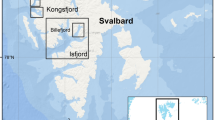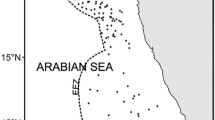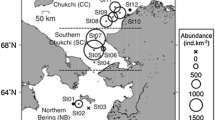Abstract
We investigated current diets of the six most abundant benthic fish in the northern Bering Sea. Our objective was to explore feeding strategies and potential competition with other top predators as ecosystem changes occur in the northern Bering Sea ecosystem. Our approach used stomach content data collected from field sampling during spring 2006 and 2007. Calanoid copepods and ampeliscid amphipods were important prey of Arctic cod (Boreogadus saida) but in different proportions depending upon fish size, feeding location, and local environmental conditions. Snailfish (Liparidae) occupied a broad niche and fed on a variety of benthic amphipods. Arctic alligatorfish (Ulcina olrikii) and Arctic staghorn sculpin (Gymnocanthus tricuspis) consumed ampeliscid amphipods predominantly. Shorthorn sculpin (Myoxocephalus scorpius) had a less-diverse diet, with snow crab (Chionoecetes opilio) most important by weight. Finally, all Bering flounder (Hippoglossoides robustus) sampled had empty stomachs. Our results indicate that ampeliscid amphipods, which have high biomass in the central region of the northern Bering Sea, are the most important prey for the dominant groundfish in the Chirikov Basin. Generally, all dominant benthic fish in the northern Bering Sea had narrow feeding niches, except snailfish. High diet overlap was found among many of the fish species, including Arctic cod and snailfish, snailfish and Arctic alligatorfish, and Arctic alligatorfish and Arctic staghorn sculpin. These findings are consistent with a relatively short food chain for benthic fish that are for the most part specialized feeders with narrow preferences for food and may be affected by changes in benthic prey distributions.







Similar content being viewed by others
References
Amundsen PA, Gabler HM, Staldvik FJ (1996) A new approach to graphical analysis of feeding strategy from stomach contents data—modification of the Costello (1990) method. J Fish Biol 48:607–614
Aydin K, Mueter F (2007) The Bering Sea—A dynamic food web perspective. Deep-Sea Res II 54:2501–2525
Bain H, Sekerak AD (1978) Aspects of the biology of arctic cod, B. saida, in the central Canadian Arctic. Report by LGL Ltd., Toronto, for Polar Gas Project, Toronto. 104 p
Bluhm BA, Gradinger R (2008) Regional variability in food availability for Arctic marine mammals. Ecol Appl 18:S77–S96
Bohn A, McElroy RO (1976) Trace metals (As, Cd, Cu, Fe and Zn) in Arctic cod, B. saida, and selected zooplankton from Strathcona Sound, northern Batfin Island. J Fish Res Board Can 33:2836–2840
Clarke KR, Warwick RM (2001) Change in marine communities: an approach to statistical analysis and interpretation, 2nd edn. PRIMER-E, Plymouth
Cortés E (1997) A critical review of methods of studying fish feeding based on analysis of stomach contents: application to elasmobranch fishes. Can J Fish Aquat Sci 54:726–738
Coyle KO, Gillispie JA, Smith RL, Barber WE (1997) Food habits of four demersal Chukchi Sea fishes. Am Fish Soc Symp 19:310–318
Coyle KO, Bluhm B, Konar B, Blanchard A, Highsmith RC (2007) Amphipod prey of gray whales in the northern Bering Sea: Comparison of biomass and distribution between the 1980s and 2002–2003. Deep-Sea Res II 54:2906–2918
Craig PC, Griffiths WB, Haldorson L, McElderry H (1982) Ecology studies of Arctic cod (B. saida) in Beaufort Sea Coastal Waters, Alaska. Can J Fish Aquat Sci 39:395–406
Crawford RE, Jorgenson JK (1993) Schooling behaviour of arctic cod, B. saida, in relation to drifting pack ice. Environ Biol Fish 36:345–357
Cui X, Grebmeier JM, Cooper LW, Lovvorn JR, North CA, Seaver WL, Kolts JM (2009) Spatial distributions of groundfish in the northern Bering Sea in relation to environmental variation. Mar Ecol Prog Ser 393:147–160
Davis AJ, Jenkinson LS, Lawton JH, Shorrocks B, Wood S (1998) Making mistakes when predicting shifts in species range in response to global warming. Nature 391:783–786
Dolbeth M, Martinho F, Leitão R, Cabral H, Pardal MA (2008) Feeding patterns of the dominant benthic and demersal fish community in a temperate estuary. J Fish Biol 72:2500–2517
Gradinger R, Bluhm B (2004) In situ observations on the distribution and behaviour of amphipods and Arctic cod (B. saida) under the sea ice of the High Arctic Canada Basin. Polar Biol 27:595–603
Grebmeier JM (2012) Shifting patterns of life in the Pacific Arctic and Sub-Arctic Seas. Annu Rev Mar Sci 4:63–78. doi:10.1146/annurev-marine-120710-100926
Grebmeier JM, Dunton KH (2000) Benthic processes in the northern Bering Sea/Chukchi Seas: status and global changes. In: Huntington HP (ed) Impacts of changes in sea ice and other environmental parameters in the Arctic. Report of the Marine Mammal Commission workshop, 15–17 February 2000, Girdwood, Alaska, USA
Grebmeier JM, Harrison NM (1992) Seabird feeding on benthic amphipods facilitated by gray whale activity in the northern Bering Sea. Mar Ecol Prog Ser 80:125–133
Grebmeier JM, Overland JE, Moore SE, Farley EV, Carmack EC, Cooper LW, Frey KE, Helle JH, McLaughlin FA, McNutt SL (2006) A major ecosystem shift in the northern Bering Sea. Science 311:1461–1464
Heide-Jørgensen MP, Laidre KL, Litovka D, Villum Jensen M, Grebmeier JM, Sirenko BI (2012) Identifying gray whale (E. robustus) foraging grounds along the Chukotka Peninsula, Russia, using satellite telemetry. Polar Biol. doi:10.1007/s00300-011-1151-6
Highsmith RC, Coyle KO (1990) High productivity of northern Bering Sea benthic amphipods. Nature 344:862–864
Highsmith RC, Coyle KO (1992) Productivity of arctic amphipods relative to gray whale energy requirements. Mar Ecol Prog Ser 83:141–151
Hop H, Welch HE, Crawford RE (1997) Population structure and feeding ecology of Arctic cod schools in the Canadian high Arctic. Am Fish Soc Symp 19:68–80
Hunt GL, Coyle KO, Eisner LB, Farley EV, Heintz RA, Mueter F, Napp JM, Overland JE, Ressler PH, Salo S, Stabeno PJ (2011) Climate impacts on eastern Bering Sea foodwebs: a synthesis of new data and an assessment of the Oscillating Control Hypothesis. ICES J Mar Sci 68:1230–1243
Lawlor LR (1980) Overlap, similarity, and competition coefficients. Ecology 61(2):245–251
Linton RL, Davies RW, Wrona FJ (1981) Resource utilization indices; an assessment. J Anim Ecol 50:283–293
Lonne OJ, Gulliksen B (1989) Size, age and diet of polar cod, B. saida (Lepechin 1773), in ice covered waters. Polar Biol 9:187–191
Loughlin TR, Sukhanova IN, Sinclair EH, Ferrero RC (1999) Summary of biology and ecosystem dynamics in the Bering Sea. In: Loughlin TR, Ohtani K (eds) Dynamics of the Bering Sea. University of Alaska Sea Grant, Fairbanks, Alaska, pp 387–407
Lovvorn JR, Richman SE, Grebmeier JM, Cooper LW (2003) Diet and body condition of spectacled eiders wintering in pack ice of the Bering Sea. Polar Biol 26:259–267
Lovvorn JR, Grebmeier JM, Cooper LW, Bump JK, Richman S (2009) Modeling marine protected areas for threatened eiders in a climatically changing Bering Sea. Ecol Appl 19:1596–1613
Lowry LF, Frost KJ (1981) Distribution, growth, and foods of Arctic cod (B. saida) in the Bering, Chukchi, and Beaufort Seas. Can Field-Nat 95:186–191
Mecklenburg CW, Mecklenburg TA, Thorsteinson LK (2002) Fishes of Alaska. American Fisheries Society, Bethesda, Maryland
Moore SE, Grebmeier JM, Davies JR (2003) Gray whale distribution relative to forage habitat in the northern Bering Sea: current conditions and retrospective summary. Can J Zool 81:734–742
O’Connell CP (1980) Percentage of starving northern anchovy, Engraulis mordax, larvae in the sea as estimated by histological methods. Fish Bull 78:475–489
Obst BS, Hunt GL Jr (1990) Marine birds feed at gray whale mud plumes in the Bering Sea. Auk 107:678–688
Overland JE, Stabeno PJ (2004) Is the climate of the Bering Sea warming and affecting the ecosystem? EOS Trans Am Geophys Union 85:309–316
Sigler MF, Renner M, Danielson SL, Eisner LB, Lauth RR, Kuletz KJ, Logerwell EA, Hunt GL (2011) Fluxes, fins, and feathers. Relationships among the Bering, Chukchi, and Beaufort Seas in a time of climate change. Oceanography 24:113–127
Sogard SM (1997) Size-selective mortality in the juvenile stage of teleost fishes: a review. Bull Mar Sci 60:1129–1157
Stabeno PJ, Overland JE (2001) Bering Sea shifts toward an earlier spring transition. EOS Trans Am Geophys Union 82:317–321
Tynan C, DeMaster DP (1997) Observations and predictions of Arctic climate change: potential effects on marine mammals. Arctic 50:308–322
Warburton K, Blaber SJM (1992) Patterns of recruitment and resource use in a shallow-water fish assemblage in Moreton Bay, Queensland. Mar Ecol Prog Ser 90:113–126
Wiens JA (1993) Fat times, lean times and competition among predators. Trends Ecol Evol 8:348–349
Woodward G, Hildrew AG (2002) Body-size determinants of niche overlap and intraguild predation within a complex food web. J Anim Ecol 71:1063–1074
Wyllie-Echeverria T, Wooster WS (1998) Year-to-year variations in Bering Sea ice cover and some consequences for fish distributions. Fish Oceanogr 7:159–170
Zaret TM, Rand AS (1971) Competition in tropical stream fishes: support for the competitive exclusion principle. Ecology 52:336–342
Acknowledgments
We thank Dr. R. Brown for lending her taxonomic expertise in the identification of fish prey. We thank the crew, officers, and particularly the marine science technicians from the USCGC Healy for sampling support at sea. We thank the chief editor and three anonymous reviewers for constructive comments that helped us to improve a prior version of the manuscript. Support for this research was provided by the U.S. National Science Foundation through OPP-ARC-0454454. The State of Tennessee also provided fellowship support to X. Cui through the University of Tennessee, Knoxville.
Author information
Authors and Affiliations
Corresponding author
Rights and permissions
About this article
Cite this article
Cui, X., Grebmeier, J.M. & Cooper, L.W. Feeding ecology of dominant groundfish in the northern Bering Sea. Polar Biol 35, 1407–1419 (2012). https://doi.org/10.1007/s00300-012-1180-9
Received:
Revised:
Accepted:
Published:
Issue Date:
DOI: https://doi.org/10.1007/s00300-012-1180-9




